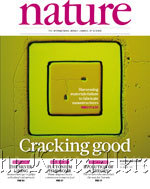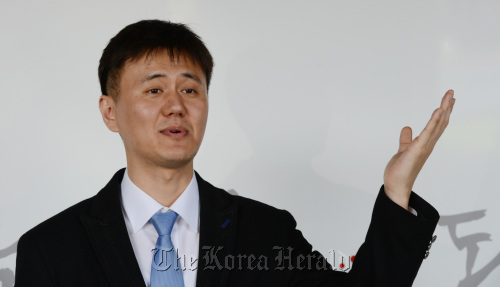Nam Koo-hyun speaks out on online argument over breakthrough researchAfter his breakthrough research in nanotechnology headlined the top science journal “Nature,” Nam Koo-hyun is never jubilant.
Upon the publication, the research professor at Ewha Womans University, was embroiled in an ethics dispute with one of his assistants claiming her efforts at experiment were extorted. A “witch hunt” ensued many laymen describing him as a viscous exploiter.
“It was frustrating,” the 33-year-old scientist told The Korea Herald on Tuesday.
“I think I should celebrate, not castigate. I feel sad about this whole situation and at the moment I cannot carry on with my research because of the rumors,” he added.
Nam discovered a way to control nano-scale cracks on certain materials for the first time in groundbreaking work expected to bring a huge change in nanotechnology.
But the Ph.D. student claimed she should have authorship of the research on an online debate site on May 8, the day before the world’s most authoritative science journal published Nam’s paper as its cover story.
“I had sleepless nights conducting experiments. … I also discovered new ides during the process, but he (Nam) is acting like he’s done all the work,” she wrote.
Nam strenuously dismissed the claim, saying: “I made it clear to her in the beginning why she can’t be a co-author.”
“My policy is that performing experimental tasks does not qualify one for authorship,” he said, arguing that her lack of understanding of authorship on scientific papers has sparked such a dispute.
Nam noted that he has been working together with the graduate student since he joined Ewha Womans University in 2010.
Although she played a major role in experimental design and data interpretations, still she did not engage “intellectually,” in his projects, Nam said.
Nam claimed that he first came up with the idea of controlling cracks in 2007 while studying mechanical engineering at the University of California, Berkeley.
He discovered that cracks regularly developed in prism panels, but he waited to return to Korea to develop his research.

 |
Nam Koo-hyun |
“If I had my work published in Nature during my Ph.D., nobody would blame me like this,” he said.
He meant that some have pointed fingers at him in favor of the student because he is a professor.
“I’m just a contracted research professor. Look, this tie is the only one I have at the moment,” he said while straightening it.
Meanwhile, Nature Publishing Group said it had no plans to take any action on Nam’s case.
“This is an issue that will first need to be resolved between the author of the Nature paper and the complainant,” a press officer from the Nature told The Korea Herald.
“Any potential action on the part of Nature would depend on the nature of any such resolution,” she added.
During the interview, Nam tried to be calm, but he became emotional when he said he had already decided to leave the university.
Nam noted that he submitted his resignation three months ago despite his contract running until 2013.
“I couldn’t stay any longer. I had an uneasy relationship with the head of our research center,” he confessed.
The reason, he added, was because of another authorship dispute over his cracking research with the senior professor Park Il-hung of Ewha Womans University.
“Park first complained about his role after we received a positive response from Nature in 2011,” Nam said.
When Nam first contacted Nature in 2011, he wrote three names on the paper ― his name along with KAIST professor Ko Seung-hwan as corresponding authors and professor Park as a co-author.
According to Nature’s policy, the corresponding author is solely responsible for communicating with the journal before and after publication.
“He wanted to be a corresponding author, so he told me to correct it.” But Nam ignored his request. Then the trouble started.
“For my understanding, the corresponding author should have in-depth knowledge of the research. But Park had no intellectual input into the work,” he said.
He could have accepted Park’s request to avoid any trouble, but it was against his principles.
“Even if a Nobel Prize winner wants to put his name on my paper, I won’t allow it, if he has no knowledge of my research,” he said.
Professor Park of Ewah Womans University did not respond to phone calls for comment.
Nam’s team used silicon wafers, thin slices of semiconductor material, in their experiment.
They created micro-scale cuts in a thin brittle film deposited on the silicon in order to control the starting point of the crack, and put a “crack-stop-structure” to terminate the cracking.
By doing this they were able to create nano-channels that are small enough to separate ions or molecules.
Until now it has been difficult to make individual artificial channels that narrow using the current method of cutting with an electronic beam.
Nam, however, suggests they can produce nano-channels more easily by using their cracking-control method, saving costs and process time significantly.
Nam had a hard time becoming a scientist. After he graduated from high-school, he went to work at a ready-mix concrete company instead of university due to his family circumstance. He later had the chance to work at the Korea Aerospace Research Institute, and this led him to study in the United States.
Nam said that he now wants to shy away from the public eye.
“I hope this whole dispute will fade away soon, so that I can refocus and develop my research,” he added.
By Oh Kyu-wook (
596story@heraldcorp.com)









![[Today’s K-pop] Blackpink’s Jennie, Lisa invited to Coachella as solo acts](http://res.heraldm.com/phpwas/restmb_idxmake.php?idx=644&simg=/content/image/2024/11/21/20241121050099_0.jpg)